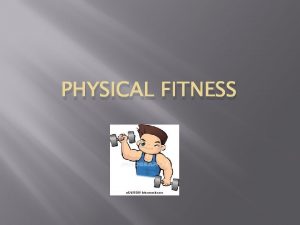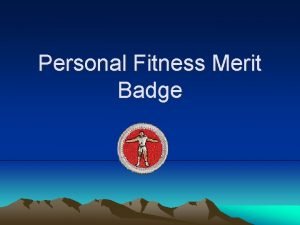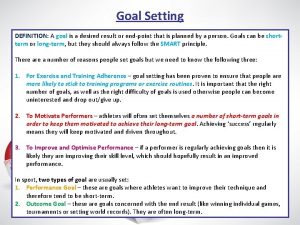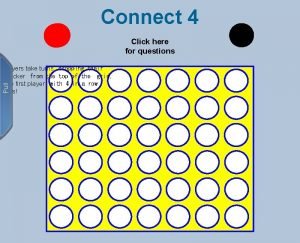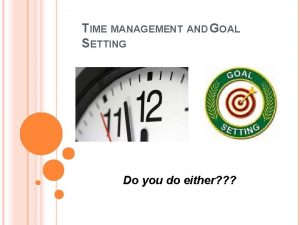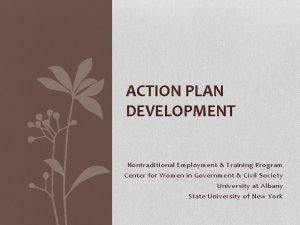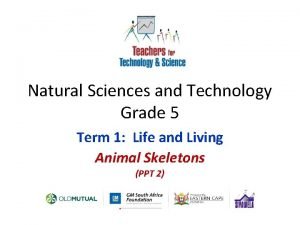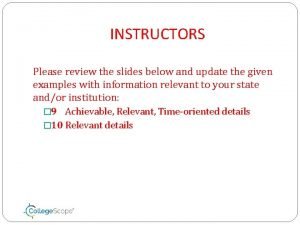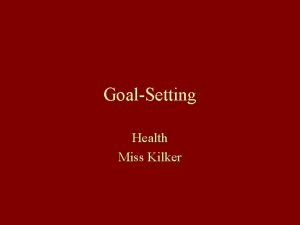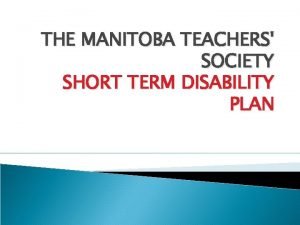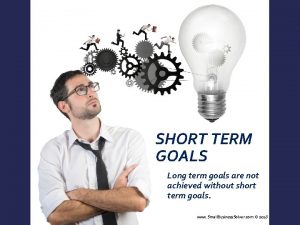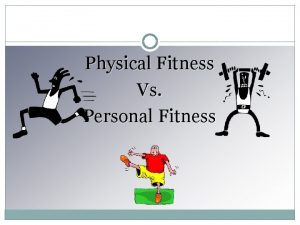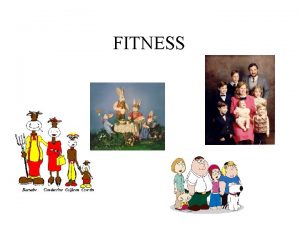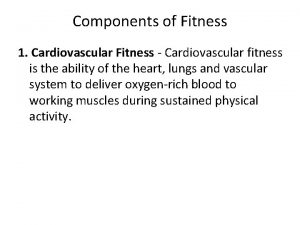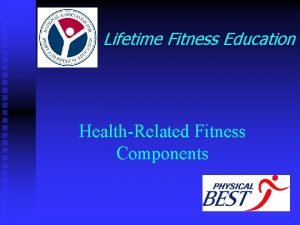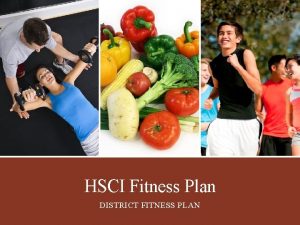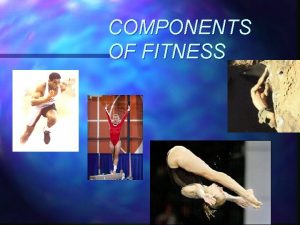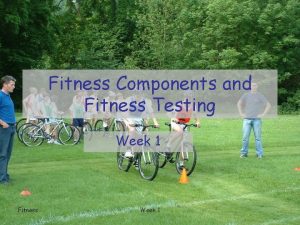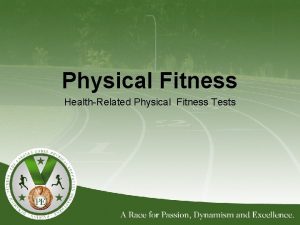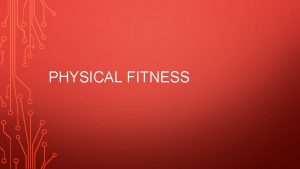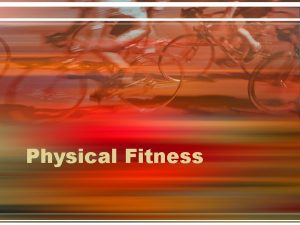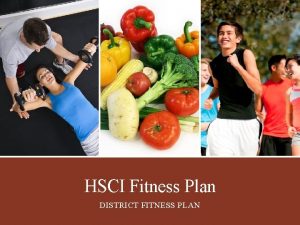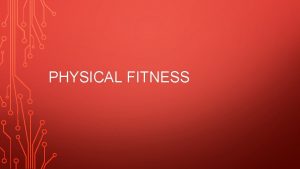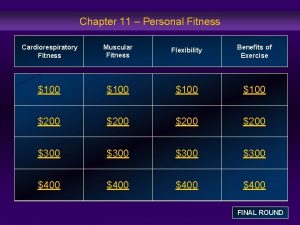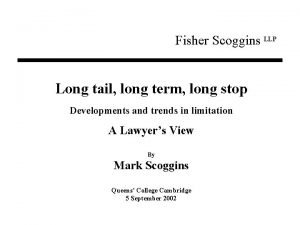Fitness Workout Preparation Goals workout plans long term

















































- Slides: 49

Fitness

Workout Preparation • Goals & workout plans • long term goals, short term goals, achievable and unrealistic goals • Deciding whether to use free weights or machines (or both)

Motivation - Intrinsic • Intrinsic motivation: is a type of motivation comes from rewards inherent to a task or activity itself. • Ex: “Jim likes to exercise because it makes him feel healthy. ”

Motivation - Extrinsic • Extrinsic motivation: is a type of motivation that comes from an outside source. • Ex: “Dan exercises because his friends are all exercising and he doesn’t want to be left out. ”

Activity Choice • Choose activities that keep your interest! • You are more likely to stop exercising if you get bored, so choose activities that are fun as well as beneficial. Switch activities often so that you don’t fall into a boring routine.

“Workout buddy” • Having a workout buddy or workout group can be beneficial for motivation as well as safety

Warm-ups • Warm-up before activity by increasing HR to get muscles warm and lax so they can be stretched. Warm-ups usually include some sort of cardio activity (jogging, riding a stationery bike).

Stretching the muscles is important. It can help with overall flexibility as well as help prevent injury during activity. Types of stretching (static, dynamic, passive)

Dynamic Stretching • Utilizes momentum from form in an effort to propel the muscle into an extended range of motion. Too much force results in ballistic stretching.

Static stretching • Stretching a limb beyond its normal range of motion, held for at least 10 seconds

Passive stretching • Joint flexibility is improved by stretching caused by another person who moves the limb to its end position and kept there for a few seconds.

The FITT Principle • Frequency: how often one has to exercise to improve • • their level of fitness Ex: (3 times a week) Intensity: how hard one works to improve their level of fitness Ex: (working to reach your target heart rate) Time: how long one has to exercise to improve their level of fitness Ex: (30 minutes of a cardiovascular workout) Type: what kind of exercise one is doing Ex: (aerobic, anaerobic, isokinetic, isometric, isotonic)

Overload Principle • States that a gradual increase in overload will help to • achieve higher levels of fitness. Ex: lifting heavier weights will make the muscles stronger so that they are able to lift more weight

Principle of Specificity • States that only specific exercises improve specific components of fitness. • Ex: Arm curls will benefit the biceps muscle.

Anaerobic vs. Aerobic • Aerobic exercise: activity lasting longer than 2 minutes. Increases lung’s ability to hold oxygen. • Ex: distance running, swimming, cycling

Anaerobic vs. Aerobic • Anaerobic exercise: activity lasting from 2 seconds up to 2 minutes. Intense, short burst of energy that require a lot of stored energy. • Ex: a football tackle, hitting a baseball, sprinting

Isometrics • Isometric exercise is a form of exercise involving • • the static contraction of a muscle without any visible movement in the angle of the joint. Examples: Structural items (e. g. , pushing against a door frame) Free weights, weights machines or elastic equipment (e. g. holding a weight in a fixed position)

Isokinetics • Isokinetic exercises are resistance-based exercises designed to provide a specific level of resistance while maintaining a consistent speed of limb movement. The idea behind isokinetic exercise is to achieve the highest degree of muscle contraction while also promoting a free range of movement of the limbs.

Isotonics • An exercise that usually involves raising and lowering a weight. The muscles are used in a normal dynamic way contracting at a speed controlled by the subject

The Cool Down • Cool down exercises involve exercises that decrease in intensity. For example you run hard and then you slow down a little bit and then you walk. After you finish the exercises you should let your heart and breathing to reach the normal level.

Injuries/Injury Prevention • Strengthening areas of the body can help to prevent injury. Likewise, proper education about specific exercises and machines can help to eliminate most accidents that lead to injury.

Importance of Rest • Rest is VERY IMPORTANT TO THE BODY! A good 8 hours of sleep/night does a body good. But sleep isn’t the only kind of rest our body needs. Rest in between activity is important too. • Ex: Doing an upper body workout on a Monday, then waiting again until at least Wednesday to do it again.

Proper Form/Technique • While exercising or weight lifting, proper form and technique can greatly reduce the risk of injury as well as ensure proper growth. Be sure to read all instructions on machines or to ask someone knowledgeable such as a personal trainer or specialist

Muscle Injuries • Strains- tearing or stretching of muscle fibers as a • • • result of suddenly pulling them too far. Bruise- discolored area under the skin caused by leakage of blood after an injury. Tendinitis- inflammation of a tendon, usually caused by overuse Hernia- the protrusion of an organ or tissue through a weak area in the muscle

Agonist vs. Antagonist • Agonist: muscle that causes specific movement or • • • possibly several movements to occur through the process of its own contraction (also called “prime movers”) Ex: while doing an arm curl, the bicep is the agonist muscle Antagonist: muscle that acts in opposition to the specific movement generated by the agonist and is responsible for returning a limb to its initial position. Ex: while doing an arm curl, the tricep is the antagonist muscle

Muscles & Muscle Groups • Abdominals, Biceps, Triceps, Deltoids (delts), Pectorals (pecs), Latissimus Dorsi (lats), Quadriceps (quads), Hamstrings, Gluteus Maximus (glutes), Gastrocnemius (calves)

Abdominals • The abdominal muscles support the trunk, allow • • movement and hold organs in place by regulating internal abdominal pressure. Strengthen: crunches, sit-ups, side bends, Pilates Stretch: trunk rotator, overhead stretch

Biceps • The biceps are used to rotate the forearm (supination) and to flex the elbow. • Strengthen: bicep curls, push-ups, pull-ups • Stretch: standing biceps stretch

Triceps • The triceps are responsible for extension of the elbow joint. • Strengthen: triceps pushdowns, push-ups • Stretch: overhead and side triceps stretch

Deltoids • The prime mover of arm abduction along the • • frontal plane. The arm must be internally rotated for the deltoid to have maximum effect. Strengthen: shoulder press, dead lift, shoulder shrugs, push-ups. Stretch: arm circles, elbow circles, hug yourself

Pectoral • The pectoral muscles are • • responsible for movement of the shoulder joint. Strengthen: bench press, push up, flies Stretch: shoulder shrug backwards, chair upper body stretch

Latissimus Dorsi • The latissimus dorsi is responsible for • • extension, adduction, transverse extension also known as horizontal abduction, flexion from an extended position, and internal rotation of the shoulder joint. Strengthen: lat pull down, bentover/seated row, chin up/pull up Stretch: torso reach

Quadriceps • All four quadriceps are powerful • • extensors of the knee joint. They are crucial in walking, running, jumping and squatting. Strengthen: seated leg press, squats Stretch: butterfly, straddle, standing quad stretch

Hamstrings • The hamstrings play a crucial • • role in many daily activities, such as, walking, running, jumping, and controlling some movement in the trunk. In walking, they are most important as an antagonist to the quadriceps in the deceleration of knee extension. Strengthen: leg curls, leg extension Stretch: leg-up stretch, side lunge, runner’s stretch

Gluteus Maximus • Its most powerful action is to • • cause the body to regain the erect position after stooping, by drawing the pelvis backward. When the gluteus maximus takes its fixed point from the pelvis, it extends the femur and brings the bent thigh into a line with the body. Strengthen: kickbacks, leg press, leg lifts, lunges, squats, buns of steel Stretch: glute getter, hip stretch, butt burner

Calves • Its function is plantar flexing the • • foot at the ankle joint and flexing the leg at the knee joint. Strengthen: leg press, leg extension, calf raises Stretch: toe touch, ankle circles,

Weight management • Sedentary lifestyle- inactivity • “Couch potato” • Health risks include weight gain, diabetes, cardiovascular disease, loss of muscle tone

Metabolism • The rate at which your body gets energy from food. It varies from person to person according to: • Age, gender, body composition, climate, activity level. • A higher metabolism will burn more calories instead of storing them as fat.

Calories • Anything you eat or drink (with the exception of water) contains calories. Calories are the units of heat energy from food. There are 2, 500 calories in one pound. So…… • If we eat more calories than we burn, it results in weight gain, if we burn more calories than we eat, we lose weight.

Calories • How can you lose 1 pound of fat in a week? • Since there are 2, 500 cal/lb, we can divide that number by 5 to get 500. So…… • If we burn off 500 more calories a day than we eat, we can lose a lb/week!

Safety • Education: You should know the basics of proper dieting, gym/workout form & technique, and injury prevention/management before starting a workout plan

Climate/Environment • Your surroundings during exercise can play a major role in your safety. Factors such as heat, cold, altitude, and an overall dangerous environment can be hazardous.

Heat related Heat-related Heat exhaustion- overheating of the body, resulting in cold, clammy skin and symptoms of shock as well as dizziness, headache, shortness of breath, and nausea Heat stroke- the body’s inability to rid itself of excess heat. The body temperature rises and the person will have difficulty breathing and can collapse.

Cold-related Cold Related Frostbite- a condition that results when body tissue becomes frozen. Hypothermia- a condition in which the body temperature becomes dangerously low.

Other Hazards • Use common sense! Don’t go jogging in a thunderstorm, mountain-climb by yourself, or even swim by yourself. If something should happen, no one will be around to save you. Your “workout buddy” can be useful.

Harmful Substances • Anabolic steroids- drugs which mimic the effects of the • male steroids testosterone and dihydrotestosterone. They increase protein synthesis within cells, which results in the buildup of cellular tissue (anabolism), especially in muscles. Adverse effects: high blood pressure, reduced sexual function, acne, depression, psychosis, mania, aggression (roid rage), suicide

Unhealthy Weight Loss • Losing weight in a controlled, progressive fashion is healthy. Losing weight in sudden large bursts can be harmful to the body.

Harmful Substances • HGH, or Human Growth hormone is a protein-based • poly-peptide hormone. It stimulates growth and cell reproduction and regeneration in humans. Adverse effects: Regular application of extra GH may show several negative side-effects such as joint swelling, joint pain, carpal tunnel syndrome, and an increased risk of diabetes. Other side effects can include less sleep needed after dosing. This is common initially and decreases in effect after habitual use of HGH.

Harmful Substances • Diet pills- Anti-obesity medication or weight loss drugs refer to all • pharmacological agents that reduce or control weight. These drugs alter one of the fundamental processes of the human body, weight regulation, by either altering appetite, metabolism, or absorption of calories. Some anti-obesity drugs have severe or life-threatening side effects. These side effects are often associated with their mechanism of action. In general, stimulants carry a risk of high blood pressure, faster heart rate, palpitations, closed-angle glaucoma, drug addiction, restlessness, agitation, and insomnia.
 Physical activities done at home
Physical activities done at home Example of short term goal
Example of short term goal Strategic goals tactical goals operational goals
Strategic goals tactical goals operational goals Strategic goals tactical goals operational goals
Strategic goals tactical goals operational goals Personal fitness merit badge requirements
Personal fitness merit badge requirements My ambition short essay
My ambition short essay Short term goals for teenagers
Short term goals for teenagers Long term career goals example
Long term career goals example Short term goals for teenagers
Short term goals for teenagers Definition of goal setting
Definition of goal setting Pull questions
Pull questions Short term goals
Short term goals Short term planning and long term planning
Short term planning and long term planning Long term memory vs short term memory
Long term memory vs short term memory Example of short term human resources
Example of short term human resources Difference between long term and short term liabilities
Difference between long term and short term liabilities Long-term liabilities examples
Long-term liabilities examples Short term financial management
Short term financial management Long and short
Long and short Once upon a time there lived a
Once upon a time there lived a Health vs skill related fitness
Health vs skill related fitness Examples of goals, objectives and action plans
Examples of goals, objectives and action plans General goals and specific goals
General goals and specific goals Motivation in consumer behaviour
Motivation in consumer behaviour Ns project grade 7 term 3
Ns project grade 7 term 3 Creative arts grade 8 visual art
Creative arts grade 8 visual art Natural science and technology grade 6 term 4
Natural science and technology grade 6 term 4 Natural science grade 7 notes
Natural science grade 7 notes Technology grade 7 term 3 notes
Technology grade 7 term 3 notes Natural science term 2
Natural science term 2 Animal skeletons grade 5
Animal skeletons grade 5 A long walk to water final project ideas
A long walk to water final project ideas Smart short-term goals examples
Smart short-term goals examples Short-term health goals
Short-term health goals Nursing diagnosis for grieving
Nursing diagnosis for grieving Short term goals for self-esteem
Short term goals for self-esteem Short term goals for self-esteem
Short term goals for self-esteem Long time goals
Long time goals Term-to-term rule
Term-to-term rule Nth term of a quadratic sequence
Nth term of a quadratic sequence Term to term rule
Term to term rule Minterm and maxterm
Minterm and maxterm Rules in finding the nth term
Rules in finding the nth term Term to term rule
Term to term rule Institutional medicaid
Institutional medicaid Long term financing
Long term financing Long term scheduler
Long term scheduler Gsa long term lodging
Gsa long term lodging Manitoba teachers society long term disability
Manitoba teachers society long term disability Putting-out system
Putting-out system
